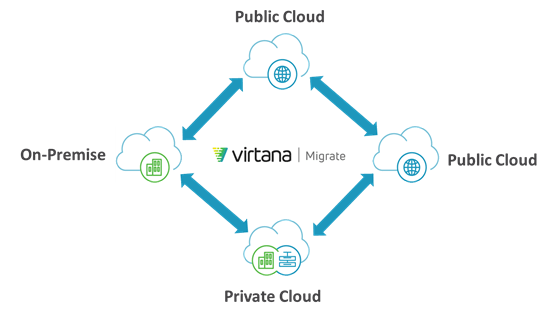We often talk about migrating applications to THE cloud, or running workloads in THE cloud, as if the cloud is one, homogenous environment. The reality is, of course, far more complex. There are private clouds and public clouds—and different public cloud service providers (CSPs) that each have their own particular capabilities and strengths. Modern, digitally transformed businesses usually leverage a combination of these clouds. In fact, our own recent survey found that 84% of respondents are running workloads in multiple public/private clouds. If each cloud operates as a silo, you could face a slew of monitoring, management, optimization, reporting, and other challenges. That’s why delivering maximum business benefits from your digital transformation over time requires you to build a multi-cloud mindset. To do that, you need to master four imperatives.
MULTI-CLOUD IMPERATIVE #1: Know which CSP to choose for a given workload, and which configuration is ideal for your cost and risk requirements.
For some workloads, it may be obvious which public cloud to use. But if it’s not, you need a way to evaluate which CSP will be the best fit or if you are better off modernizing by migrating to a private cloud. Of course, it’s not just about the provider; you also need to select the optimal configuration to meet your cost, performance, and risk needs. Given that any single CSP offers options that can number in the hundreds of thousands of permutations—with new types, sizes, and generations being introduced a lower cost on a regular cadence—this can be a daunting task. The only way you can evaluate your myriad options across multiple clouds is with an automated recommendation engine that can provide you with a manageable short list of options based on the critical dimensions of your workloads and any constraints that you set.
MULTI-CLOUD IMPERATIVE #2: Manage workloads across all public and private clouds, as well as your on-premises deployments, to support ongoing business needs.
The dynamic nature of business means that your workloads are going to change and your requirements are going to shift over time. It’s a lot of moving parts to manage. Keeping everything continuously rightsized can be a challenge, but if you can’t optimize capacity and cost in real time, you could face rising costs and/or declining performance. In many cases, you may have computes that require more vCPUs for a workload. You need to, however, pay attention to all dimensions, such as memory, network, and particularly disk IO. For database servers, it is very likely that the original compute selection was driven by disk IO throughput or IOPS demands forcing you to use a compute “T-shirt size” that came with a number of vCPU that exceeds the workload CPU MHz requirements. On top of that, you want to ensure you’re not paying for any cloud resources you’re not using—for example idle instances, storage on stopped instances, or unattached storage. You need real-time data collection and analytics that you can deploy consistently across your entire multi-cloud infrastructure to automatically optimize instances and identify cloud waste before it takes a big bite out of your budget.
MULTI-CLOUD IMPERATIVE #3: Easily migrate workloads across different cloud environments as needed.
Although still rare, sometimes you may need to migrate workloads from one public cloud environment to another, whether that’s physical locations, regions/zones, or even a different CSP altogether (or back on premises). In fact, your cloud ecosystem could be operating under a minimal perpetual state of migration of one sort or another. You need to operationalize migration with a platform and processes to track those moves across all your public cloud and your private cloud/on-premises infrastructure.
MULTI-CLOUD IMPERATIVE #4: Understand and report on application/workload utilization, performance, cost, etc. by segments that are meaningful to the business (i.e., not by CSP).
Each CSP will provide you with analytics and reporting for that particular environment. This is useful from an operational perspective but it doesn’t go nearly far enough for three key reasons. First, it may not provide you with all the information you need to effectively manage your cloud costs even within that particular public cloud. Second, it probably does not allow you to analyze utilization and spend from a business perspective, for example by cost center (here are some examples for AWS). And finally, it doesn’t provide you with a consistent way to view any information—operational or business-focused—across your entire multi-cloud environment. This last point isn’t a failing on the part of your CSPs. You can’t expect them to provide robust reporting and analytics for clouds other than their own. So, if you don’t want to spend a lot of time stitching together disparate data from multiple CSPs to get a global view of your cloud utilization, performance, and cost, you need a platform that will provide visibility into your entire multi-cloud environment.
Building a multi-cloud mindset is easier with Virtana
With Virtana Platform, you can master all of the multi-cloud imperatives with on-premises, hybrid cloud, and multi-cloud performance, cost, and control.

The combination of AIOps, machine learning, and data-driven analytics enables efficient migration and ongoing performance, capacity, and cost optimization. Request a free trial today.

Ricardo Negrete




